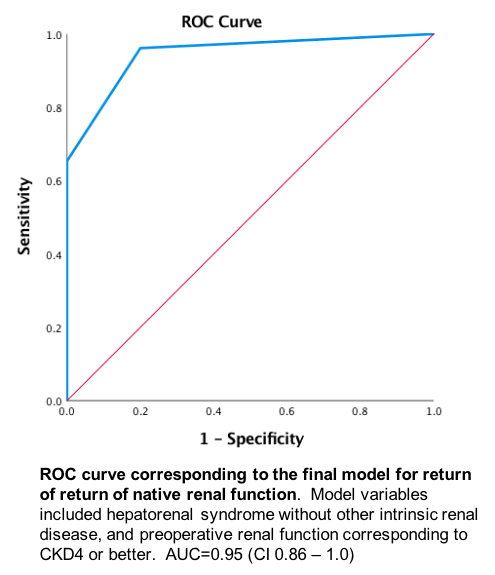Back
Poster, Podium & Video Sessions
Moderated Poster
MP36: Renal Transplantation & Vascular Surgery
MP36-07: Mag-3 scan reveals simultaneous liver-kidney transplantation is accompanied by significant return of native renal function
Sunday, May 15, 2022
7:00 AM – 8:15 AM
Location: Room 228
Glenn T. Werneburg, David Goldfarb, Daniel Hettel*, Alvin Wee, Cleveland, OH
- DH
Daniel Hettel, MD
Cleveland Clinic
Poster Presenter(s)
Introduction: Due to commonly comorbid renal insufficiency in liver failure, simultaneous liver-kidney transplant (SLK) has become an increasingly popular option. Following SLK, renal function improves, but it is unknown whether this is due to function of the transplant kidney, return of function of the native kidneys, or both. We sought to determine the return of native renal function following SLK and investigate predictive factors.
Methods: Patients who received SLK then underwent Mag-3 scan following their serum creatinine nadir as part of a quality initiative, and review of the cohort was IRB-approved. The relative contribution of each kidney was calculated based on Mag-3 and eGFR. Patients with good return of native renal function (native contribution eGFR=30) were compared to those with poor return of native renal function (native contribution eGFR <30) using descriptive statistical analysis, and a final logistic regression model and ROC curve were generated.
Results: 31 of 34 patients who underwent SLK from August 2019 to May 2021 at our institution were included in analysis. 3 patients had no Mag-3 performed due to scheduling issues. At baseline, 42% of patients had ESRD, 29% had CKD4/5, and 29% had CKD3. Following SLK, average native-only kidney contribution to overall renal function was 51.1%, corresponding to average native-only eGFR 44.5 (SD 15.2). The transplant kidney’s contribution to overall renal function was 49.0%. 26 of 31 (83.9%) patients had native kidney-only contribution of eGFR of 30 (CKD3) or better. Hepatorenal syndrome, without other original disease was a significant predictor of good return of native renal function (OR 32.0, 95% CI: 1.56 – 656, p=0.025). The final model, which also included preoperative CKD4 or better, was accurate with 93.5% of the cases predicted correctly (p=0.0003). The associated area under the ROC curve was 0.95 (CI: 0.86 – 1.0, Figure).
Conclusions: Simultaneous liver-kidney transplantation is often accompanied by return of native renal function. Hepatorenal syndrome without other original disease is a predictor of good return of native renal function. Randomized trials are needed to determine which patients would be best suited for SLK versus liver transplant alone, with the later option for subsequent kidney transplant via the safety net mechanism.
Source of Funding: N/A

Methods: Patients who received SLK then underwent Mag-3 scan following their serum creatinine nadir as part of a quality initiative, and review of the cohort was IRB-approved. The relative contribution of each kidney was calculated based on Mag-3 and eGFR. Patients with good return of native renal function (native contribution eGFR=30) were compared to those with poor return of native renal function (native contribution eGFR <30) using descriptive statistical analysis, and a final logistic regression model and ROC curve were generated.
Results: 31 of 34 patients who underwent SLK from August 2019 to May 2021 at our institution were included in analysis. 3 patients had no Mag-3 performed due to scheduling issues. At baseline, 42% of patients had ESRD, 29% had CKD4/5, and 29% had CKD3. Following SLK, average native-only kidney contribution to overall renal function was 51.1%, corresponding to average native-only eGFR 44.5 (SD 15.2). The transplant kidney’s contribution to overall renal function was 49.0%. 26 of 31 (83.9%) patients had native kidney-only contribution of eGFR of 30 (CKD3) or better. Hepatorenal syndrome, without other original disease was a significant predictor of good return of native renal function (OR 32.0, 95% CI: 1.56 – 656, p=0.025). The final model, which also included preoperative CKD4 or better, was accurate with 93.5% of the cases predicted correctly (p=0.0003). The associated area under the ROC curve was 0.95 (CI: 0.86 – 1.0, Figure).
Conclusions: Simultaneous liver-kidney transplantation is often accompanied by return of native renal function. Hepatorenal syndrome without other original disease is a predictor of good return of native renal function. Randomized trials are needed to determine which patients would be best suited for SLK versus liver transplant alone, with the later option for subsequent kidney transplant via the safety net mechanism.
Source of Funding: N/A


.jpg)
.jpg)